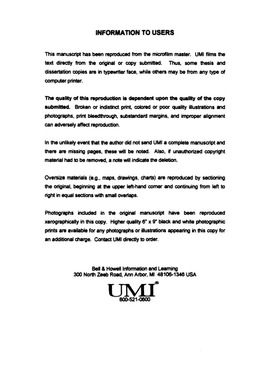| dc.contributor.advisor | Schubert, Karel R., | en_US |
| dc.contributor.author | Cao, Yajuan. | en_US |
| dc.date.accessioned | 2013-08-16T12:30:53Z | |
| dc.date.available | 2013-08-16T12:30:53Z | |
| dc.date.issued | 2000 | en_US |
| dc.identifier.uri | https://hdl.handle.net/11244/5954 | |
| dc.description.abstract | The technique of in situ hybridization was used to localize the IMPDH mRNA in soybean nodules. Mature nodules were fixed in 4% paraformaldehyde and 0.25% glutaraldehyde, dehydrated and embedded in Paraplast. Sections of 7--10 mum in thickness were prepared. A DIG-labeled antisense RNA probe, chemically hydrolyzed to a size of 150--200 bases, was used to hybridize to the pre-treated sections at 50--55° C. DIG-RNA:RNA hybrids were detected with AP-conjugated anti-DIG antibody. IMPDH gene expression was observed in soybean nodule cells infected with rhizobia, while uninfected cells and peripheral tissues were not labeled. | en_US |
| dc.description.abstract | Differential expression of the IMPDH gene in soybean was studied at both the transcriptional and translational levels by Northern blot analysis, Western blot analysis and IMPDH activity assays. Results showed that IMPDH is a nodulin, that is expressed specifically in nodules. IMPDH transcripts and protein were not detected in roots, epicotyls, buds, stems, leaves, flowers, pods and immature seeds. The expression of IMPDH in nodules was induced between 8 to 13 days after inoculation (DAI) with Bradyrhizobium japonicium. The expression level increased until 21 DAI and then remained fairly constant until 36 DAI. Two different immunoreactive bands were observed by Western blot analysis using anti-recombinant IMPDH antibody. These two bands were approximately 52 kDa and 48 kDa in size based on analysis by SDS-PAGE. | en_US |
| dc.description.abstract | In order to obtain antibodies against soybean nodule IMPDH, soybean IMPDH cDNA was subcloned in a pET-32 vector and expressed in E. coli. Three different expression hosts, E. coli strain BL21(DE3)LysS, AD494(DE3) and AD494(DE3)LysS were used for expression at different temperatures. Under the optimal temperature, the recombinant IMPDH fusion protein accumulated in inclusion bodies. After inclusion body isolation, purification and solubilization, IMPDH fusion protein was purified by affinity chromatography and anion-exchange chromatography under denaturing conditions in the presence of 6 M urea. Following 12.5% SDS-PAGE and staining with 0.25 M KCl, the target protein was sliced from the gel, lyophilized and ground into a fine powder. The powder was then used to immunize rabbits for antibody preparation. The molecular weight of the IMPDH fusion protein was ∼ 70 kDa by SDS-PAGE. | en_US |
| dc.description.abstract | Inosine monophosphate dehydrogenase (IMPDH, E.C. 1.1.1.205) is a key enzyme in ureide-producing nodules of tropical legumes. A soybean nodule IMPDH cDNA was cloned by screening a soybean nodule CDNA library (in lambda gt11) with degenerate probes. The full length of the IMPDH cDNA was 2016 bp with a 166 bp 5'-untranslated region and a 341 bp 3'-untranslated tail. The open reading frame encodes a polypeptide of 502 amino acids with a predicted molecular weight of 53 kDa and a pI of 5.54. The deduced amino acid sequence was 70.5% identical to that of Arabidopsis and contains the putative active-site region. Southern blotting of digested soybean genomic DNA suggested that there was only one copy of the IMPDH gene in the soybean genome. Functional complementation experiments showed that expression of soybean IMPDH cDNA in E. coli mutant strain KLC381 ( DeltaguaB) could restore IMPDH activity and allow the bacteria to grow on minimal media. | en_US |
| dc.format.extent | xvii, 207 leaves : | en_US |
| dc.subject | Agriculture, Plant Culture. | en_US |
| dc.subject | Rhizobium. | en_US |
| dc.subject | Soybean. | en_US |
| dc.subject | Root-tubercles. | en_US |
| dc.subject | Dehydrogenases. | en_US |
| dc.subject | Biology, Microbiology. | en_US |
| dc.subject | Biology, Molecular. | en_US |
| dc.subject | Biology, Plant Physiology. | en_US |
| dc.title | Cloning, characterization, expression and localization of inosine-5'-monophosphate dehydrogenase (IMPDH) cDNA/mRNA in soybean (Glycine max) nodules. | en_US |
| dc.type | Thesis | en_US |
| dc.thesis.degree | Ph.D. | en_US |
| dc.thesis.degreeDiscipline | Department of Microbiology and Plant Biology | en_US |
| dc.note | Adviser: Karel R. Schubert. | en_US |
| dc.note | Source: Dissertation Abstracts International, Volume: 61-02, Section: B, page: 0671. | en_US |
| ou.identifier | (UMI)AAI9962983 | en_US |
| ou.group | College of Arts and Sciences::Department of Microbiology and Plant Biology | |
